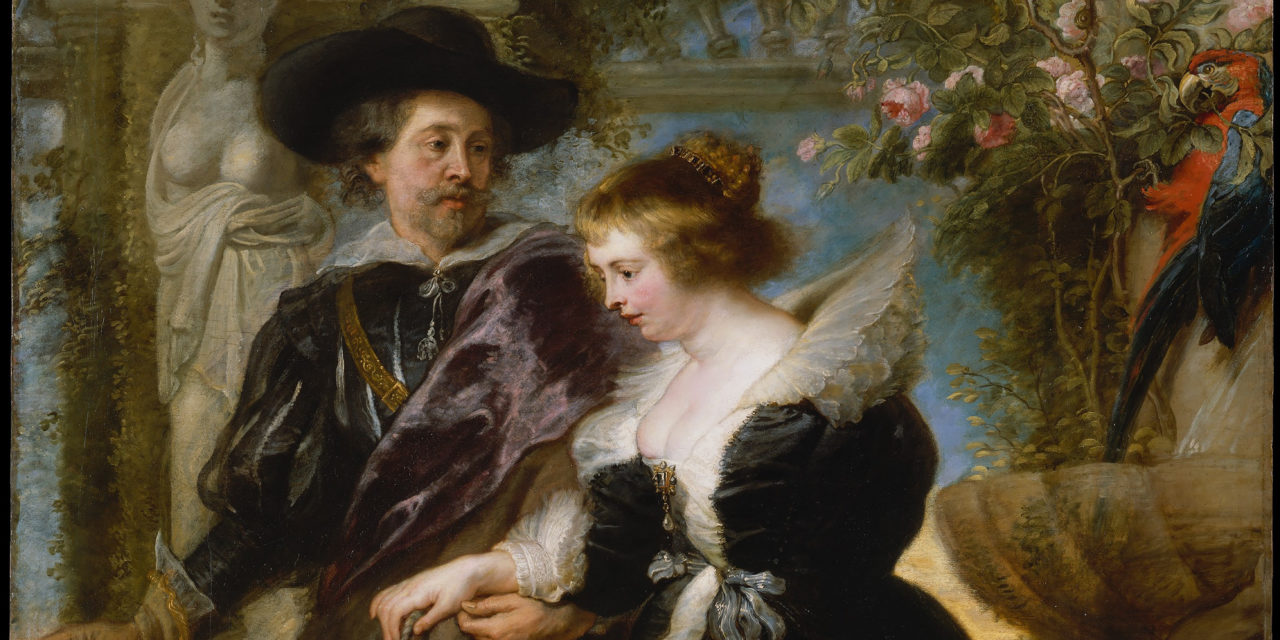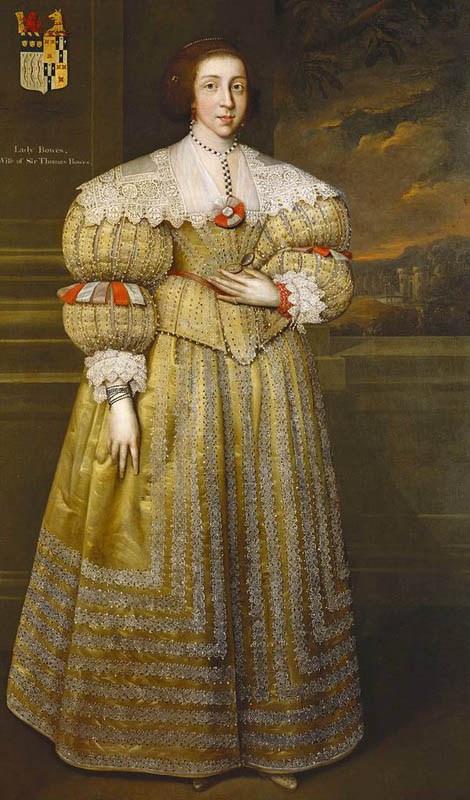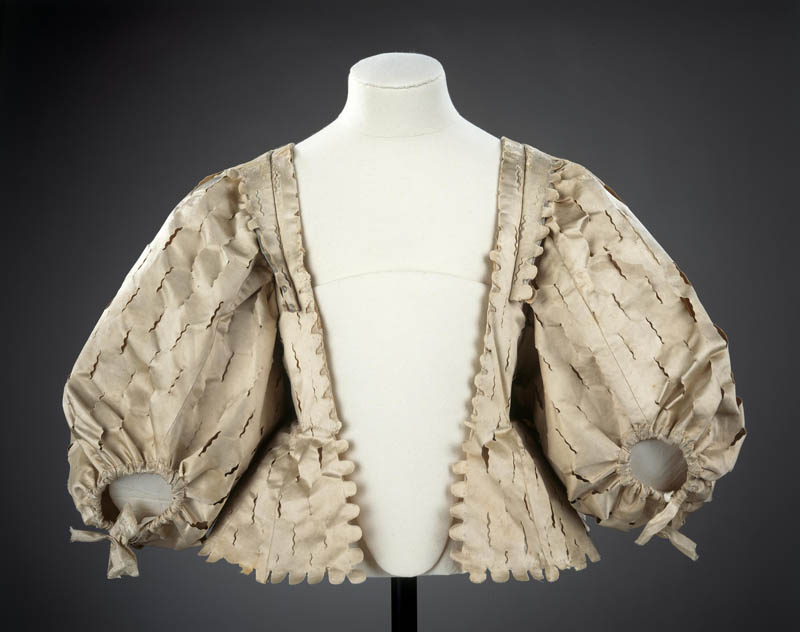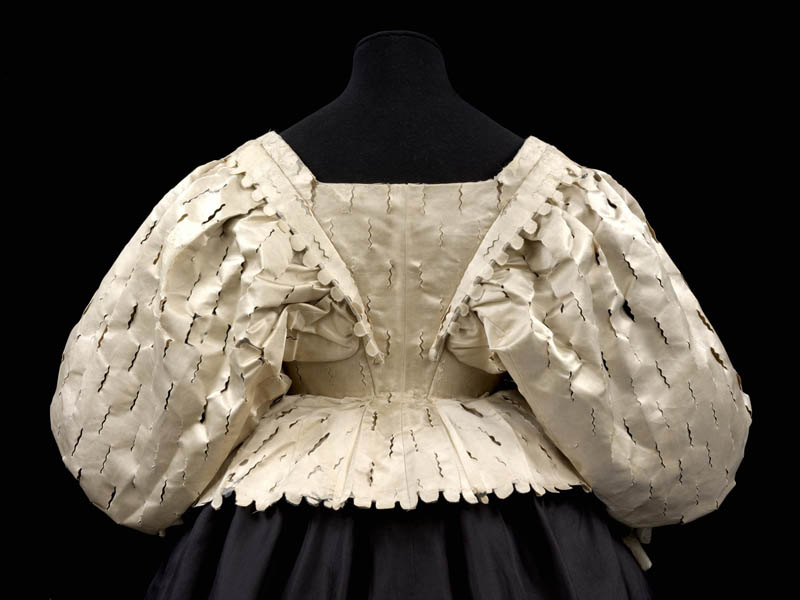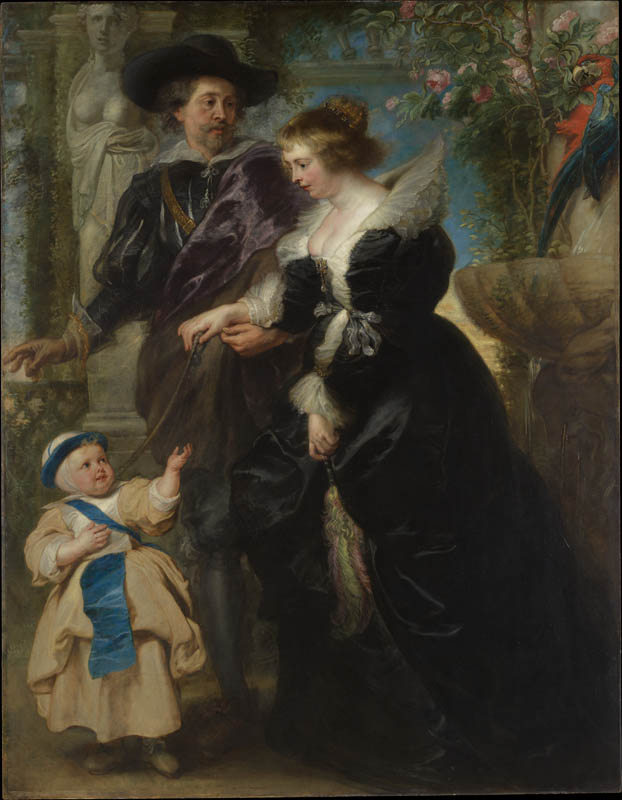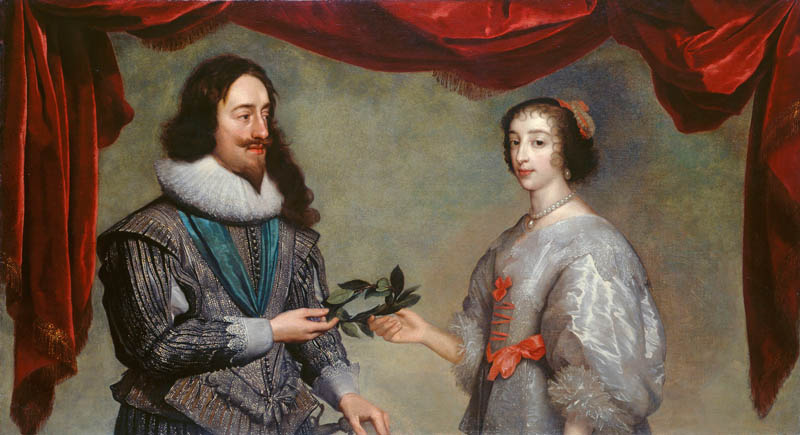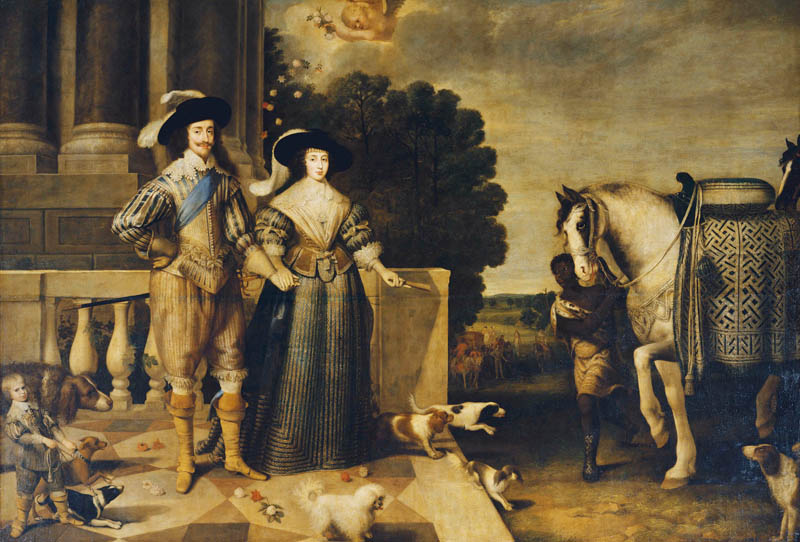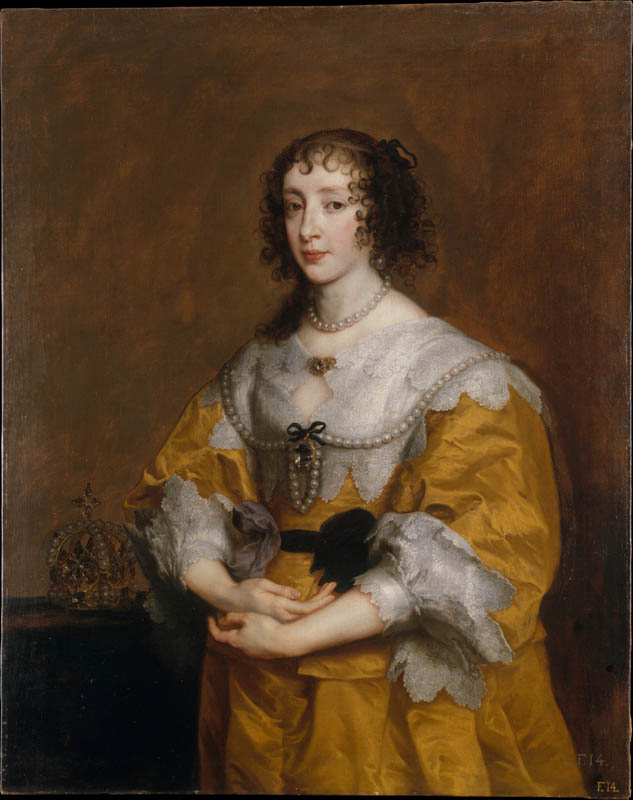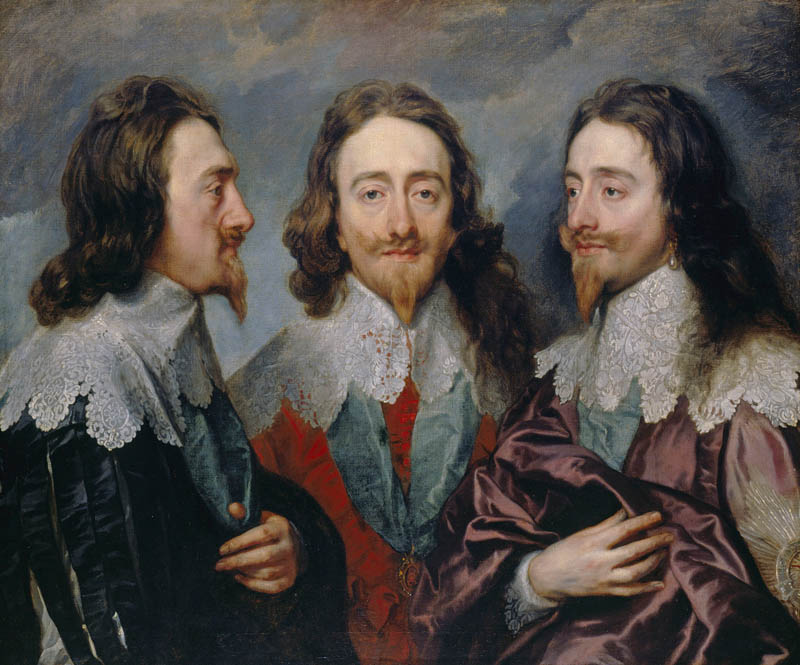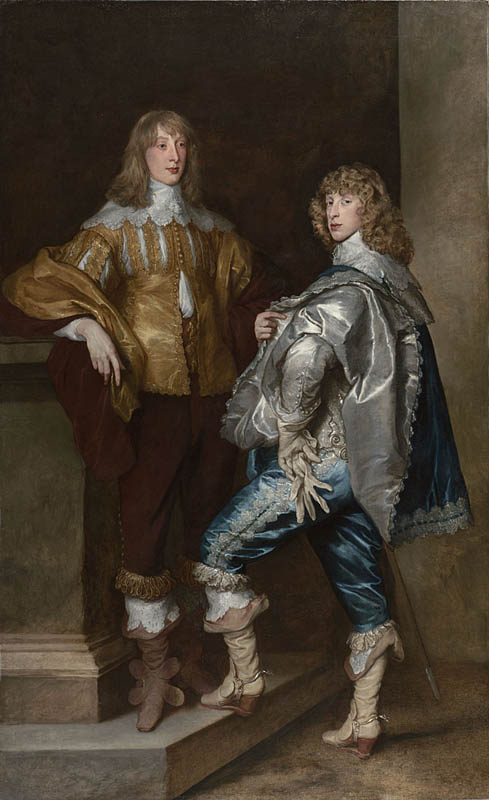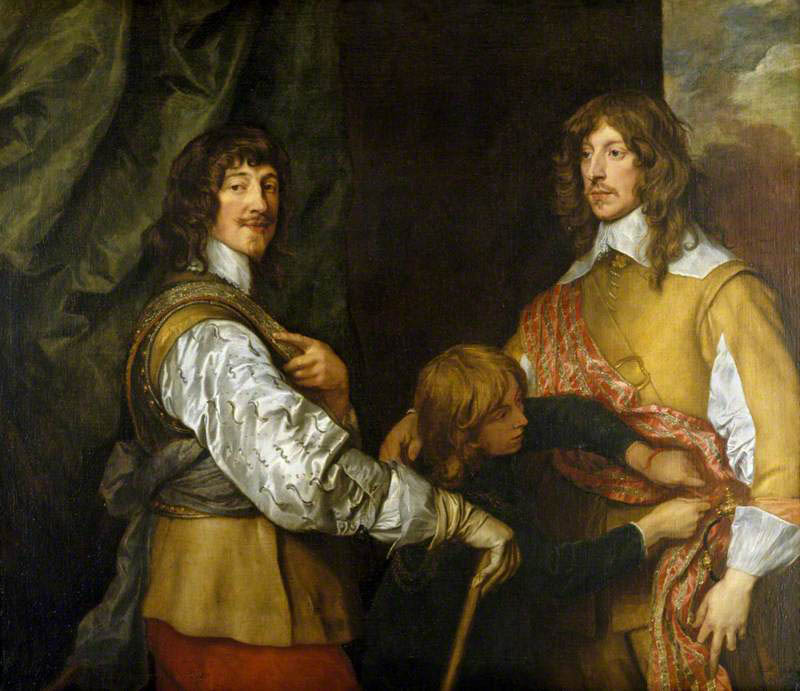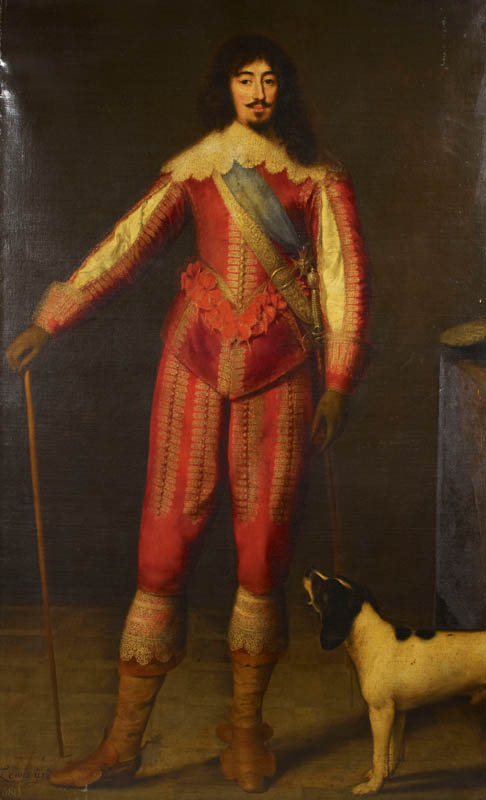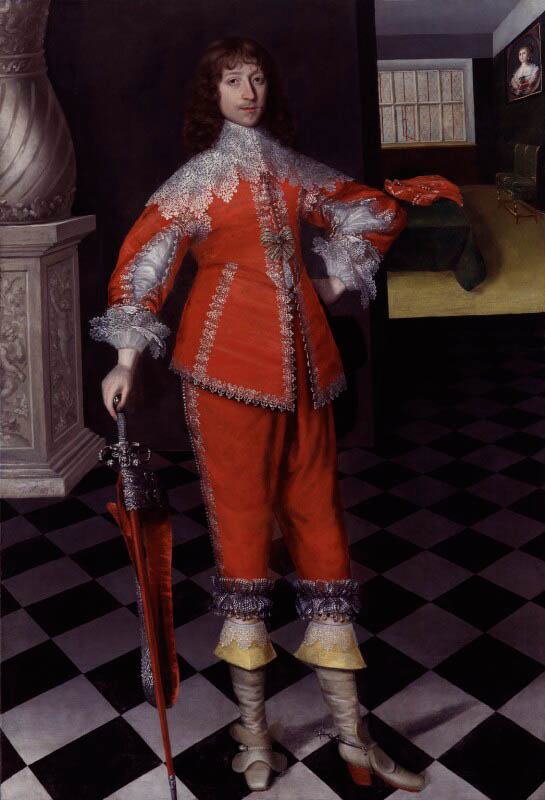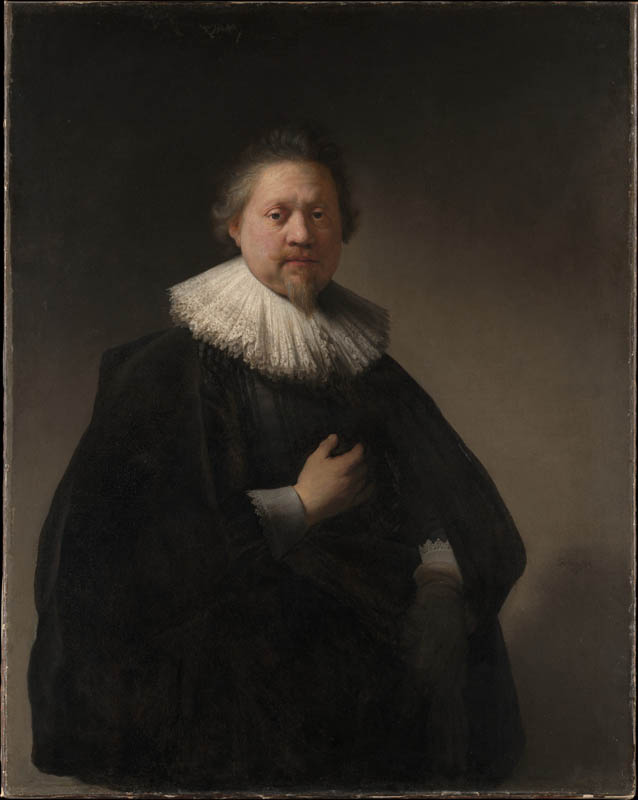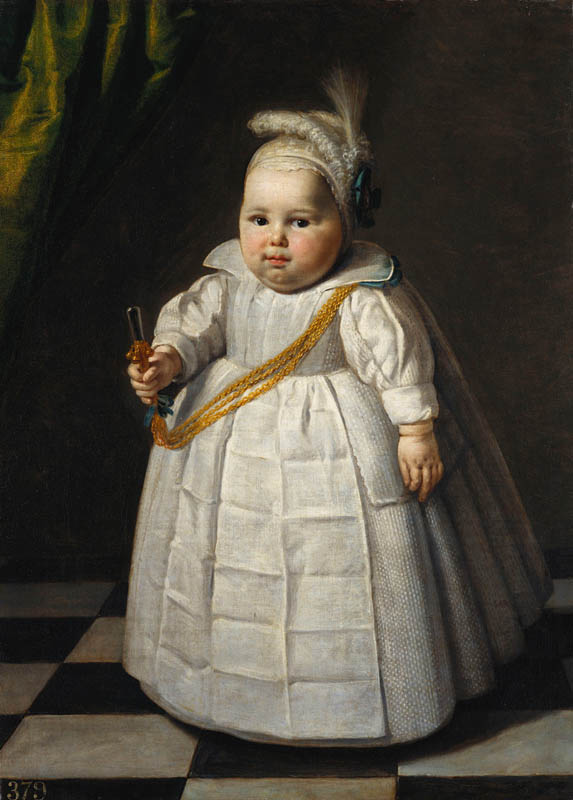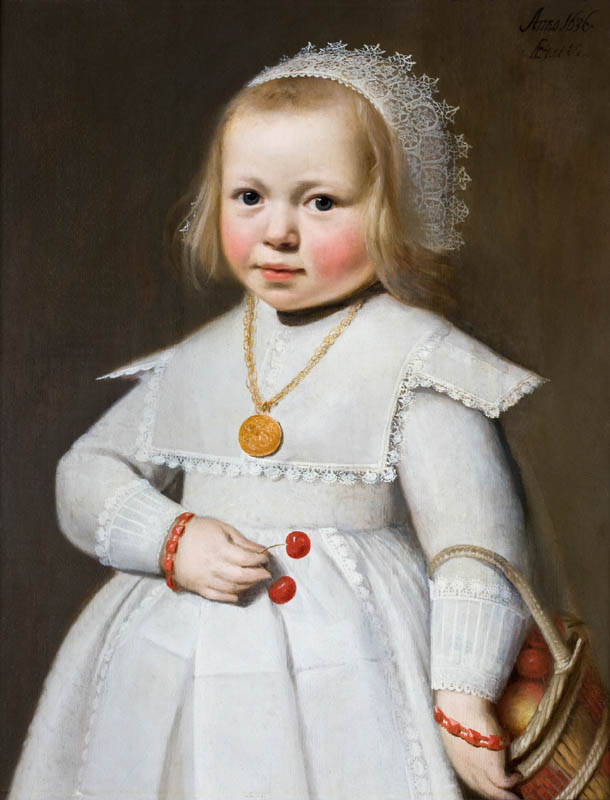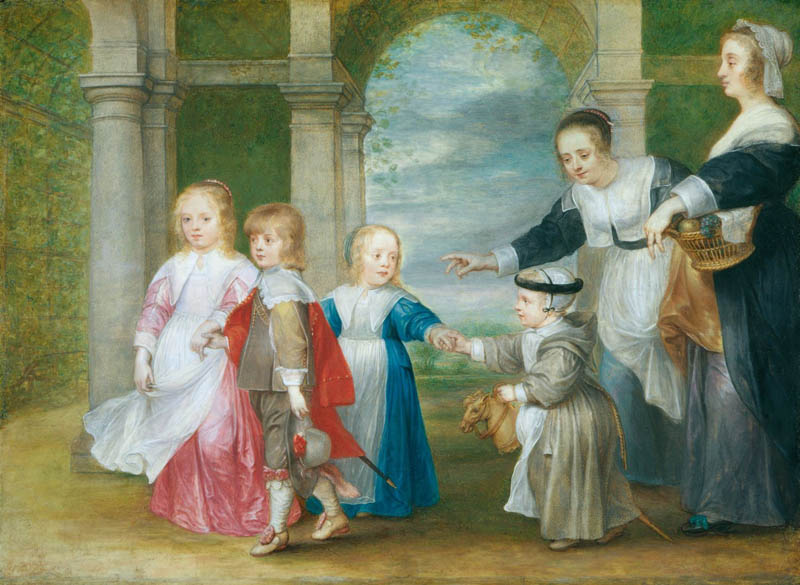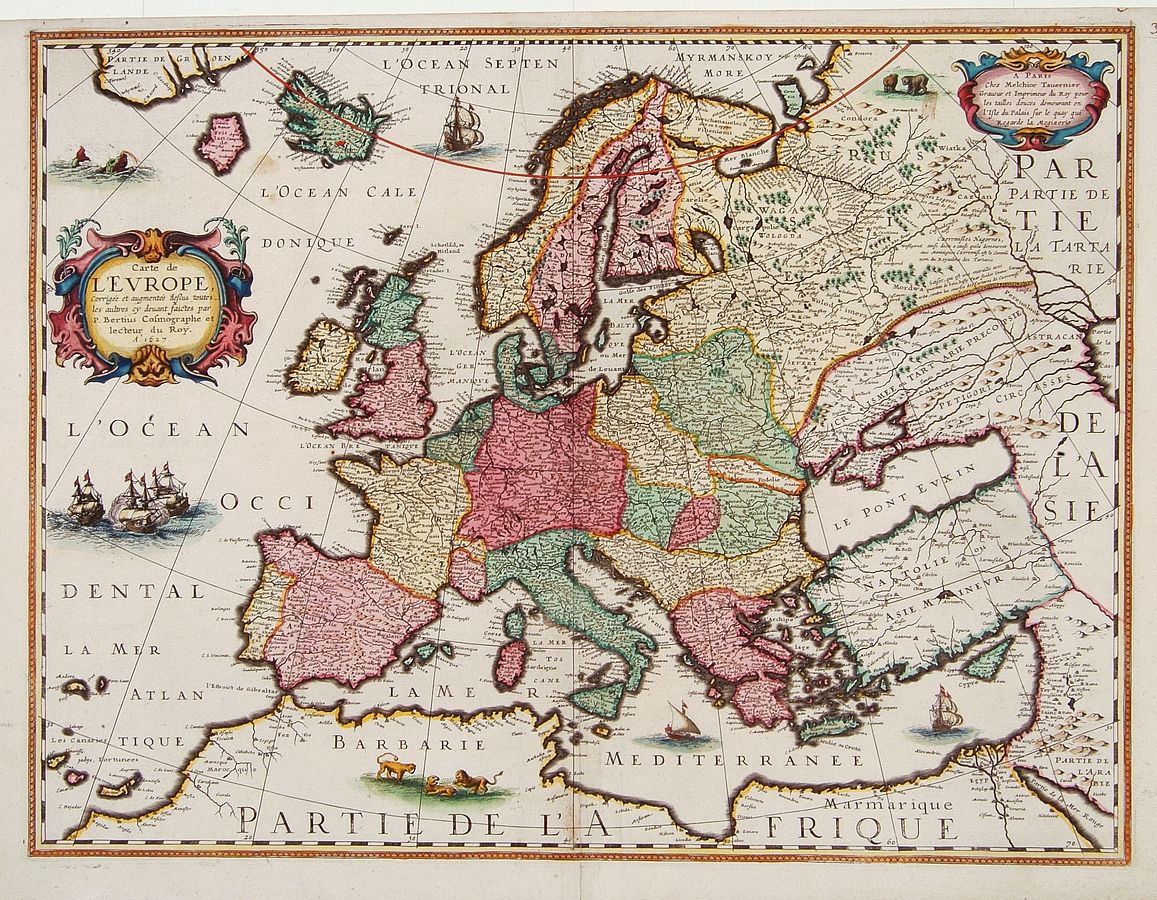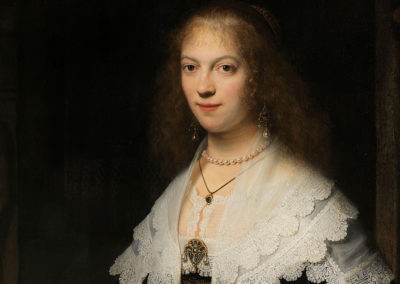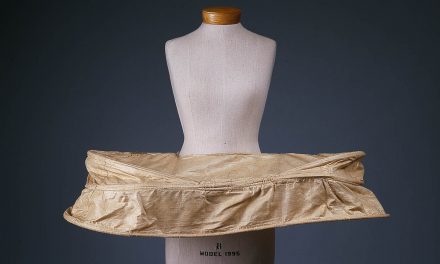OVERVIEW
For men, the 1630s was an age of leather, long locks and lace, while women shimmered in soft satins and plenty of lace of their own.
Womenswear
In the 1630s, womenswear featured broad shoulders and high waists, which fashion-forward women had already begun to adopt in the previous decade. France continued to set the styles worn by the elite in France, England and the Netherlands. Soft, shimmering satins, often in light colors, were favored. Lace collars could either stand off the shoulders with the use of wire supports or lie flat. Matching lace cuffs were worn and lace frequently edged the often-low square necklines. Sleeves were very full, typically paned leg-of-mutton sleeves that were cinched in the middle with a ribbon or rosette—the combination became known as virago sleeves.
Anthony van Dyck’s portrait of Marguerite de Lorraine (Fig. 1), Duchess of Orléans, shows all of these typical features. She also wears a black satin gown over her silver satin bodice and petticoat. Lady Bowes (Fig. 2) shows the adoption of these French trends in England. She is dressed nearly identically to the duchess, except that her lace collar is draped over her shoulders rather than standing off of them. She also lacks the additional layer of the gown; Daniel Delis Hill explains that this was typical of English women in his History of World Costume and Fashion (2011): “The open-front gown was less popular in England than on the Continent. Instead, ladies preferred the closed-front gown, or even more, the short jacket and skirt” (408). Lady Bowes bodice and skirt are covered all over by spangles (sequins punched from sheets of precious metal), as the Royal Collection Trust website notes.
Both women’s bodices are closed by stomachers, though as they are made of the same fabric as the bodices and skirts it is difficult to discern this. It is far more obvious the key role the stomacher played when looking at a surviving 1630s bodice in the Victoria & Albert Museum’s collection (Figs. 3-4). Bodices did not wrap fully around the body and the gap at the center front had to be filled by a stomacher; the V&A’s bodice lacks a stomacher as is obvious in figure 3. As stomachers were completely independent of the bodice—simply pinned into place each day—they are not often preserved together with the bodices they were typically worn with. One could wear a stomacher with multiple different bodices, after all. Hill describes the stomacher and changes to its shape in the 1630s:
“The open front of the bodice was filled with a stiff stomacher usually made of a matching fabric although some were covered with lace… The waistline point in the front formed more of a rounded U-shape than the decades-old V-tip.” (407)
Fig. 1 - Anthony van Dyck (Flemish, 1599-1641). Marguerite de Lorraine, Madame, duchesse d'Orléans, ca. 1634. Oil on canvas; 135.6 x 99.7 cm. Private Collection. Source: Wikipedia
Fig. 2 - British School (1700s). Lady Bowes, Wife of Sir Thomas Bowes, Inscribed in 1630. London: Royal Collection Trust, RCIN 409146. Source: The Royal Collection Trust
Fig. 3 - Maker unknown (English). Bodice (front), 1630-1639. Silk satin, silk taffeta, canvas, buckram and whalebone, handsewn; 42.5 x 88 cm. London: Victoria & Albert Museum, 172-1900. Source: V&A
Fig. 4 - Maker unknown (English). Bodice (rear), 1630-1639. Silk satin, silk taffeta, canvas, buckram and whalebone, handsewn; 42.5 x 88 cm. London: Victoria & Albert Museum, 172-1900. Source: V&A
As figure 4 reveals, bodice sleeves were set deep into the back of the bodice. For more on English fashion of the 1630s, see the “Fashion Icon” section below on Queen Henrietta Maria.
A painting by Louise Moillon (Fig. 5) gives us a rare side-by-side view of elite and common dress as it shows an elegant woman selecting produce from a fruit and vegetable seller. The woman at left is richly dressed in black satin, with virago sleeves, a standing lace collar, and a lace-trimmed stomacher. The merchant woman is wearing humbler garments that mimic the silhouette of the time, with fuller sleeves and a low-squared neckline, here filled in with her linen chemise, but in far less expensive materials and without the decorative details of the dress of her customer.
Rubens’ young wife Helena Fourment (Fig. 6) is dressed in the latest French fashions as well, again in black satin; notably her neckline is not filled in by lace or her chemise, with her bust prominently on display, nearly spilling over the top of her stiff stomacher.
Fig. 5 - Louise Moillon (French, 1610- 1696). The Fruit and Vegetable Costermonger, 1631. Oil on panel; 48 x 65 cm (18.8 x 25.5 in). Paris: The Louvre, RF 1955-19. Source: Wikipedia
Fig. 6 - Peter Paul Rubens (Flemish, 1577–1640). Rubens, His Wife Helena Fourment, and Their Son Frans, 1635. Oil on wood; 203.8 x 158.1 cm (80 1/4 x 62 1/4 in). New York: The Metropolitan Museum of Art, 1981.238. Gift of Mr. and Mrs. Charles Wrightsman, in honor of Sir John Pope-Hennessy, 1981. Source: The Met
Other Dutch women adopted the French style of dress, but retained their much beloved ruffs, long after women in other countries had discarded them (Brown 124). Rembrandt’s portrait of a woman (Fig. 7) shows the fashionable virago sleeves and high waist of the period, but here paired with an enormous cartwheel ruff—demonstrating that not all fashions were adopted uniformly across cultures. And, indeed, not all people of a time dressed in the latest fashions, as a portrait by Jan van Ravesteyn (Fig. 8) attests. Some chose, then as now, to dress in older styles whether due to personal aesthetic preferences, financial limitations, or group membership.
Maria of Austria (Fig. 9), Queen of Hungary, presents another interesting case in terms of fashion history. She wears a version of the now elliptical-shaped Spanish farthingale, with the deep U-shaped bodices popular a few decades earlier. Conventionally this is treated as a conservative look, maintaining past traditions, rather than as cutting edge in its style. Yet that elliptical skirt shape would become the must-have silhouette of the 18th-century—more than 70 years later. Is she ahead of her time? Or mired in the past? It’s all a matter of perspective!
Fig. 7 - Rembrandt van Rijn (Dutch, 1606-1669). Portrait of a Woman, probably a Member of the Van Beresteyn Family, 1632. Oil on canvas; 111.8 x 88.9 cm (44 x 35 in). New York: The Metropolitan Museum of Art, 29.100.4. H. O. Havemeyer Collection, Bequest of Mrs. H. O. Havemeyer, 1929. Source: The Met
Fig. 8 - Jan van Ravesteyn (Dutch, 1572–1657). Portrait of a Woman, 1635. Oil on wood; 68.3 x 58.1 cm (26 7/8 x 22 7/8 in). New York: The Met, 12.202. Gift of Henry Goldman, 1912. Source: The Met
Fig. 9 - Frans Luycks (Flemish, 1604-1668). Maria of Austria, Queen of Hungary, ca. 1635. Oil on canvas; 215 x 147 cm. Madrid: Museo del Prado, P01272. Royal Collection. Source: Museo del Prado
Fashion Icon: Henrietta Maria, Queen Consort of England
Fig. 1 - Daniel Mytens (Dutch, 1590-1647). Charles I and Henrietta Maria, 1630-1632. Oil on canvas; 95.6 x 175.3 cm. London: Royal Collection Trust, RCIN 405789. Presumably painted for Charles I. Source: RCT
Fig. 2 - Anthony van Dyck (Flemish, 1599-1641). Queen Henrietta Maria, ca. 1632. Oil on canvas; 109 x 86.2 cm. London: The Royal Collection Trust, RCIN 404430. Painted for Charles I; sold at the Commonwealth Sale to John Embree; returned at the Restoration of Charles II, 1660.. Source: RCT
Henrietta Maria (1609-166) was the youngest daughter of King Henri IV of France and Marie de’ Medici and was named after both her parents. Her brother, Louis XIII, became King when she was only a child. She married King Charles I of England in 1625 and became Queen Consort of England, Scotland and Ireland, although she was never crowned due to her Catholic faith.
Upon her arrival at the English court, she “exerted a strong influence on court fashion and protocol, and introduced continental fashions and Italianate gardens to England” (NGA). She spent lavishly on dress—attracting criticism from Puritan moralists—and had her clothes made by a French tailor, as François Boucher notes in A History of Costume in the West (1997): “After 1630, Queen Marie-Henriette of France wrote to her friend Madame de Saint-George to arrange for Pin the tailor to come to Great Britain to make her bodices and underskirts” (274). Fashion: The Definitive History of Costume and Style (2012) describes the impact of the young queen:
“She had grown up in the French court and imported grace, style, and imperial grandeur, along with a vast trousseau of clothes and jewelry. Immediately, her youth, French background and vivacious personality introduced a new sophistication to court culture, as well as the shock of the new.” (Brown 126)
After a rocky start, her marriage to Charles became a happy one and they became quite close, as an unusual double portrait by Daniel Mytens attests (Fig. 1). Both wore French fashions (see a discussion of Charles’s style in the Menswear section below) and even spoke French at court. An early portrait by van Dyck (Fig. 2) features the same dress as the Mytens’ work. The Royal Collection Trust notes that:
“In his early English portraits Anthony van Dyck includes fashionable details of dress (such as the spiky lace cuffs seen here) that he later tended to omit or simplify. The queen’s bodice and skirt have been pinked with wavy lines to produce a decorative effect in the lustrous silvery-blue silk, while the ‘carnation’ pink ribbons add warmth to the cool palette.”
This pinking effect was also used on the surviving bodice (Figs. 3-4) discussed in the Womenswear section above.
Fig. 3 - Daniel Mytens (Dutch, 1590-1647). Charles I and Henrietta Maria Departing for the Chase, 1630-1632. Oil on canvas; 282 x 408.3 cm. London: Royal Collection Trust, RCIN 404771. Purchased by Queen Victoria at the sale of the Earl of Dunmore's pictures at Christie's, 17 March 1894. Source: RCT
Fig. 4 - Anthony van Dyck (Flemish, 1599-1641). Queen Henrietta Maria with Sir Jeffrey Hudson, 1633. Oil on canvas; 219.4 x 134.8 cm (86 1/4 x 53 1/16 in). Washington: National Gallery of Art, 1952.5.39. Source: NGA
Fig. 5 - Anthony van Dyck (Flemish, 1599-1641). Queen Henrietta Maria, 1636. Oil on canvas; 105.7 x 84.5 cm (41 5/8 x 33 1/4 in). New York: The Metropolitan Museum of Art, 2019.141.10. Bequest of Mrs. Charles Wrightsman in honor of Annette de la Renta, 2019. Source: The Met
Fig. 6 - Anthony van Dyck (Flemish, 1599-1641). Queen Henrietta Maria, 1638. Oil on canvas; 78.7 x 66 cm. London: The Royal Collection Trust, RCIN 400158. Source: RCT
Another double portrait (Fig. 3) shows the royal couple setting out for a hunt. In the portrait Henrietta Maria wears virago sleeves and one can see that skirts have returned to being floor-length. On her head she wears a black Cavalier style hat ornamented with a white ostrich plume, nearly identical to that worn by Charles. The same hat reappears in a van Dyck portrait of the Queen also dressed for the hunt (Fig. 4), in which she wears a blue satin bodice and skirt trimmed in gold lace, with the same spiky lace cuffs worn at the elbows seen in figure 2. A love lock hangs down on her falling lace collar. Note that women’s sleeves have become quite shortened exposing much of the forearm.
Two other van Dyck portraits record Henrietta Maria’s famous love of pearls. One portrait from 1636 (Fig. 5) shows a long strand of pearls accenting the neckline of her bodice and forming a loop tied in a black bow at center front. The queen’s ringlets frame her face and indeed launched a fashion for ringlets at the English court. Pearls also feature prominently in a frontal 1638 portrait, which was apparently commissioned in the hopes that the Italian sculptor Bernini would carve a portrait bust like that he had done for her husband Charles I (the unusual triple portrait of Charles I by van Dyck was painted for the same reason—see figure 2 below). Anna Reynolds notes in In Fine Style (2013) that
“in day-to-day life this garment would always have been worn with a falling collar of lace that here is notably absent.” (172-73)
Henrietta Maria dressed in the latest French styles and set fashions at the English court; she would loyally campaign in support of her husband during the English Civil Wars in the next decade, but the 1630s were a happier (and more fashionable) time.
Menswear
King Charles I of England, like his French wife Henrietta Maria, also wore French fashions at court, as Boucher details:
“The remains of the Elizabethan fashions are eliminated from male costume of the Charles I period, which was very close to contemporary French styles: long-slashed doublet, breeches fastened with points tied at the waist; falling collars. The long soft tight-fitting boots are an English style, as are the long-gauntleted gloves, whose overlong fingers were padded.” (268)
This description could be of Mytens’ 1631 portrait of Charles (Fig. 1), which shows him in a doublet with panes at the chest and on the sleeves, coming to a point in the front and with points along the waist. He wears knee-high leather boots with extremely deep cuffs. It is truly an era of leather, long locks and lace.
The triple portrait of Charles by van Dyck (Fig. 2) shows him in three different satin doublets topped with beautiful lace falling collars (or bands). A very similar lace cloak band/collar (Fig. 3) survives in the collection of the Bowes Museum. His characteristic pointed beard and mustache are much in evidence and he even wears a large single pearl earring, as his friend the Duke of Buckingham (see “Fashion Icon” of the 1620s) was said to. As the Royal Collection Trust notes, “The fashion for men to wear their hair longer on the left at this date is clearly shown with the figure rotated in space.”
Fig. 1 - Daniel Mytens (Dutch, 1590-1647). King Charles I, 1631. Oil on canvas; 215.9 x 134.6 cm. London: National Portrait Gallery, NPG 1246. Purchased, 1899. Source: NPG
Fig. 2 - Anthony van Dyck (Flemish, 1599- 1641). Charles I, 1635-1636. Oil on canvas; 84.4 x 99.4 cm. London: Royal Collection Trust, RCIN 404420. Source: RCT
Fig. 3 - Maker unknown (English). Man's Cloak Band, 1635. Linen cutwork and geometric lace. London: Blackborne Collection. Source: The Bowes Museum
Henry Peacham lamented the French influence on English fashion in his Truth of our Times (1638):
“I have much wondered why our English above other nations should so much doat upon new fashions, but more I wonder at our want of wit that we cannot invent them ourselves; but when one is growne stale run presently over into France to seeke a new.” (Waugh 45)
Henry Rich, 1st Earl of Holland, wears styles similar to the King, but here with the addition of boot hose, which “were worn over the stockings; they could be full-footed or fitted only with instep straps, flaring out at the top into wide funnels trimmed with lace which spread over the boot tops” (Boucher 255). This added lace perhaps became fashionable because the large glove gauntlets now worn often covered lace cuffs at the wrists. Boots also began to feature a large butterfly-shaped latchet at the front, which was used to support the spur at the back of the boot, but also became quite prominent and decorative (Figs. 1, 4-6, 9-10).
Rich’s boots also feature slapsoles, which were “thick pieces of leather attached to the toes of shoes and boots but left loose at the heel; as the wearer walked the sole slapped against the heel” (Hill 401). Slapsoles also appear in the portrait of Lord John Stuart and his brother, Lord Bernard Stuart (Fig. 6).
Fig. 4 - Daniel Mytens (Dutch, 1590- 1647). Henry Rich, 1st Earl of Holland, ca. 1633. Oil on canvas; 221 x 134.6 cm (87 x 53 in). London: National Portrait Gallery, NPG 3770. Purchased, 1950. Source: NPG
Fig. 5 - Edward Bower (English, 1597- 1667). A Member of the Fownes Family, 1638. Oil on canvas; 233.7 x 154.9 cm. National Trust, Dunster Castle, 726087. gift from Lieutenant-Colonel Geoffrey Walter Fownes Luttrell, 1981. Source: Art UK
Fig. 6 - Anthony van Dyck (Flemish, 1599 - 1641). Lord John Stuart and his Brother, Lord Bernard Stuart, ca. 1638. Oil on canvas; 237.5 x 146.1 cm. London: The National Gallery, NG6518. Bought, 1988. Source: The National Gallery
Over the course of the decade the size of falling lace collars worn slowly expanded, perhaps to remain visible with such long hair cascading down onto the shoulders. These larger collars can be seen on a member of the Fownes family (Fig. 5) and on the Stuart brothers (Fig. 6). Breeches also narrowed and lengthened, likely due to French influence as King Louis XIII sports much longer and narrower breeches in his 1636 portrait (Fig. 9).
The portrait of the Stuart brothers (Fig. 6) also introduces an air of aristocratic negligence in that it became common late in the decade to begin to leave buttons unbuttoned. The doublet of the Stuart facing us is left two-thirds unbuttoned, exposing a great deal of his shirt at the center front. A great deal of exposed shirt is also visible in the portrait of Thomas Killgrew and William, Lord Crofts (Fig. 7). Notably the buttons up the back of the doublet here are left undone. As the Royal Collection Trust notes, “While the rather untidy appearance of the two sitters has been interpreted as a symbol of their grief, in fact they are actually following the prevailing trend for an artfully dishevelled and ‘undone’ style of male dress that was fashionable during the 1630s.”
Fig. 7 - Anthony van Dyck (Flemish, 1599-1641). Thomas Killigrew and William, Lord Crofts, 1638. Oil on canvas; 32.9 x 144.1 cm. London: Royal Collection Trust, RCIN 407426. Source: RCT
Fig. 8 - Anthony van Dyck (Flemish, 1599-1641). Mountjoy Blount, 1st Earl of Newport, Lord George Goring, and a Page, 1635-1640. Oil on canvas; 128 x 151 cm. Petworth House and Park, West Sussex, NT 486243. 3rd Lord Leconfield, who had given Petworth to the National Trust in 1947. Source: National Trust Collection
Another fashionable (and practical) trend towards the end of the decade was the wearing of leather jerkins and even leather doublets. These were called buff coats, alluding to the undyed color of the natural hide. Montjoy Blount, 1st Earl of Newport, wears a leather jerkin over a white satin doublet (Fig. 8), which is pinked in much the same manner as the woman’s bodice seen above (Figs. 3-4 in Womenswear). His compatriot, Lord George Goring, wears a leather doublet with an open seam that reveals his shirt. Both wear baldrics to support their swords and military sashes. This form of dress would become very common among royalists during the English Civil War.
Fig. 9 - Jan van Belcamp (Flemish, 1610-1653). Louis XIII, 1636. Oil on canvas; 201.6 x 122.6 cm. London: Royal Collection Trust, RCIN 404098. Source: RCT
Fig. 10 - Gilbert Jackson (English, (active 1621-1643)). Ohn Belasyse, 1st Baron Belasyse of Worlaby, 1636. Oil on canvas; 189.2 x 129.5 cm (74 1/2 x 51 in). London: National Portrait Gallery, NPG 5948. Purchased with help from the National Heritage Memorial Fund and the Art Fund, 1987. Source: NPG
Fig. 11 - Designer unknown (English). Doublet and breeches, 1630-1640. Satin, stamped, lined with linen and buckram, trimmed with braid and silk ribbon, hand-sewn. London: Victoria and Albert Museum, 348&A-1905. Source: V&A
Fig. 12 - Peter Paul Rubens (Flemish, 1577–1640). Rubens, His Wife Helena Fourment, and Their Son Frans, 1635. Oil on wood; 203.8 x 158.1 cm (80 1/4 x 62 1/4 in). New York: The Metropolitan Museum of Art, 1981.238. Gift of Mr. and Mrs. Charles Wrightsman, in honor of Sir John Pope-Hennessy, 1981. Source: The Met
Fig. 13 - Rembrandt van Rijn (Dutch, 1606–1669). Portrait of a Man, probably a Member of the Van Beresteyn Family, 1632. Oil on canvas; 111.8 x 88.9 cm (44 x 35 in). New York: The Metropolitan Museum of Art, 29.100.3. H. O. Havemeyer Collection, Bequest of Mrs. H. O. Havemeyer, 1929. Source: The Met
In France, fashion assumed a longer, sleeker line, as discussed above. Paned leg-of-mutton sleeves were abandoned in favor of narrower sleeves with open seams; breeches became longer and extended over the knee, as can be seen in a 1636 portrait of King Louis XIII (Fig. 9). Boucher notes that under Louis XIII it became more difficult to discern social rank by what a person was wearing: “The different ranks were equally well dressed and everyone aspired to carry a sword. A contemporary observed that the Parisians no longer seemed above to live without ribbons or laces or a mirror” (254).
While it is not obvious from this portrait, Louis XIII began to wear a wig in the 1630s—originally out of necessity—as Boucher explains:
“when the King lost all his hair as the result of an illness, about 1633, a new accessory appeared, the wig, initially limited to switches mingles with the wearer’s own hair, then complete. In fact, it was then worn only in cases of necessity… Natural and curled hairstyles remained in vogue… the manufacture of wigs for purposes of fashion became general only towards 1655.” (263-4)
Wigs will become much more important (and obvious) in the 18th century, when they begin to be powdered.
The longer line of dress is evident in the portrait of Ohn Belasyse (Fig. 10), 1st Baron Belasyse, as is the higher waistline that became common as well, much as in womenswear. Indeed, “By the 1630s, men’s fashions were dramatically different from styles of the early seventeenth century. Doublets were constructed with a raised waistline and a fuller, looser fit. Hooks and eyes replaced laces and points for attaching the breeches to the doublet” (Hill 399). Ribbons ending in points still adorn Louis XIII’s doublet, but do not feature on Ohn Belasyse’s. A doublet and breeches in the collection of the Victoria and Albert Museum (Fig. 11) also exhibit that higher waistline and are again decoratively pinked all over.
In the Netherlands, as in womenswear, some adopted the new French trends while others maintained earlier dress styles. Rubens portrays himself in a fashionable satin doublet with paned leg-of-mutton sleeves (Fig. 12) and a Cavalier style hat; whereas a member of the Van Beresteyn family (Fig. 13) when painted by Rembrandt chose to dress in fashions of the 1620s. The rest of Europe was increasingly consumed by the incredibly destructive Thirty Years’ War (1618-1648) and thus witnessed slower fashion change.
CHILDREN’S WEAR
Infants were swaddled, while young children were often dressed in all white. Reynolds gives an overview of children’s dress while describing a charming portrait of a young boy in the royal collection (Fig. 1):
“A 1634 portrait by Paulus Moreelse depicts a boy who will have recently made the transition into ankle-length garments, known as a ‘short coat’. Although he is probably Flemish, the clothes he wears are typical of those worn by children in England at around the same date… The Flemish boy wears a fitted bodice over a skirt, and both are protected by a bib and apron of linen. The sleeves of the bodice have slits running down their full length, a fashion also seen in adult male fashions of the same date. He wears a cap with feathers (plumes of feathers generally indicated the child was male), and holds an elaborate rattle decorated with bells, suspended from an expensive gold chain and secured with a ribbon at his shoulder…. The white apron has clearly been pressed and folded tightly for storage – the pattern of creases carefully depicted by the artist was both decorative and served as a clear indication of high standards of housekeeping.” (125-26)
A two-year-old girl painted by Jan Cornelisz Vermeyen (Fig. 2) is dressed in much the same way, with the addition of coral jewelry, which was thought to be protective and thus often given to children. A watercolor of Rubens’ four children with two maids (Fig. 3) shows the youngest still wearing the protective pudding cap (see 1620s Children’s wear to learn more), just as another Rubens’ boy does in his self-portrait with Helena Fourment discussed above (see Fig. 12 in Menswear). The older boy and two girls have already graduated to wearing miniature adult clothing; note the older son is even wearing heeled shoes and a sword attached to his baldric. The younger Don Baltazar Carlos (Fig. 4) has not reached the age of breeching (5 or 6 years old) and so wears a skirt, but he is wearing a metal gorget, or neck armor worn by adult men, and rests his left hand on his sword hilt.
Fig. 1 - Paulus Moreelse (Dutch, 1571-1638). Portrait of a Young Boy, 1634. Oil on canvas; 87.5 x 63.3 cm. Hampton Court Palace, RCIN 404734. Source: RCT
Fig. 2 - Jan Cornelisz Vermeyen (Dutch, 1500-1559). Portrait of a two-year-old girl, 1636. Oil on panel; 45 x 56 cm (22.05 in x 17.72 in). Stockholm: Hallwylska Museum, XXXII: B.127. Source: LSH database
Fig. 3 - Philip Fruytiers (Flemish, 1627-1666). Four Children of Peter Paul Rubens and Helena Fourment with Two Maids, ca. 1638-9. Watercolor, bodycolor, and pencil; 24.6 x 33.6 cm. London: Royal Collection Trust, RCIN 452433. Source: RCT
Fig. 4 - Diego Rodríguez de Silva y Velázque (Spanish, 1599- 1660). Don Baltasar Carlos with a Dwarf, 1632. Oil on canvas; 128 x 101.9 cm (50 3.8 x 40 1/8 in). Museum of Fine Arts Boston, 01.104. Henry Lillie Pierce Fund. Source: The MFA
References:
- Royal Collection Trust. “Anthony van Dyck (1599-1641) – Charles I (1600-1649).” Accessed January 16, 2020. https://www.rct.uk/collection/404420/charles-i-1600-1649.
- Royal Collection Trust. “Anthony van Dyck (1599-1641) – Queen Henrietta Maria (1609-69).” Accessed January 16, 2020. https://www.rct.uk/collection/404430/queen-henrietta-maria-1609-69.
- Royal Collection Trust. “Anthony van Dyck (1599-1641) – Thomas Killigrew and William, Lord Crofts (?).” Accessed January 16, 2020. https://www.rct.uk/collection/407426/thomas-killigrew-and-william-lord-crofts.
- Victoria and Albert Museum. “Bodice,” January 16, 2020. http://collections.vam.ac.uk/item/O115754.
- Boucher, François, Yvonne Deslandres, and John Ross. A History of Costume in the West. London: Thames and Hudson, 1997. http://www.worldcat.org/oclc/443676264.
- Brown, Susan, ed. Fashion: The Definitive History of Costume and Style. New York: DK Publishing, 2012. http://www.worldcat.org/oclc/840417029.
- Hill, Daniel Delis. History of World Costume and Fashion. Upper Saddle River, NJ: Pearson Prentice Hall, 2011. http://www.worldcat.org/oclc/768100950.
- National Gallery of Art. “Queen Henrietta Maria with Sir Jeffrey Hudson.” Accessed January 16, 2020. https://www.nga.gov/collection/art-object-page.41651.html.
- Royal Collection Trust. “Lady Bowes (1607?-1653), Wife of Sir Thomas Bowes.” Accessed January 16, 2020. https://www.rct.uk/collection/themes/exhibitions/in-fine-style/the-queens-gallery-buckingham-palace/lady-bowes-1607-1653-wife-of-sir-thomas-bowes.
- Reynolds, Anna. In Fine Style: The Art of Tudor and Stuart Fashion. London: Royal Collection Trust, 2013. http://www.worldcat.org/oclc/824726826.
- Waugh, Norah, and Margaret Woodward. The Cut of Women’s Clothes, 1600-1930. New York: Theatre Arts Books, 1968. http://www.worldcat.org/oclc/894728161.
Historical Context
Wikipedia: 1630-1639
Rulers:
- England: Charles I (1625-1649)
- France: Louis XIII (1610–1643)
- Spain: Philip IV (1621-1640)
Carte de l’Europe. Source: Wikimedia
Events:
- 1618-1638 – Thirty Years’ War
- 1637 – René Descartes’ Geometry
Primary/Period Sources
Resources for Fashion History Research
To discover primary/period sources, explore the categories below.
Have a primary source to suggest? Or a newly digitized periodical/book to announce? Contact us!
Primary/Period Sources
Secondary Sources
Also see the 17th-century overview page for more research sources… or browse our Zotero library.

